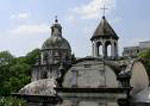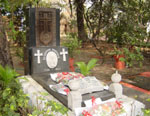DREAMS COME TRUEby David Zenian
 As the Seljuk conquest of Armenia in the 11th century and the loss of the last Armenian Kingdom in Cilicia in 1375 led to the creation of Diaspora communities worldwide, the bold efforts by a group of Armenians in the Indian city of Madras in 1772 was the first step in the long struggle for an independent Armenian state.
As the Seljuk conquest of Armenia in the 11th century and the loss of the last Armenian Kingdom in Cilicia in 1375 led to the creation of Diaspora communities worldwide, the bold efforts by a group of Armenians in the Indian city of Madras in 1772 was the first step in the long struggle for an independent Armenian state.
While living oceans away from America, where events like the Boston Tea Party and the American War of Independence were about to unfold, the Armenians of Madras were moving on a parallel track. Freedom and democracy were as much a dream for the Armenians of Madras as it was for the Founding Fathers of the United States.
Most of the small Armenian Diaspora of India in the 1700's were the descendents of the thousands of Armenians who were brought to Persia by Shah Abbas and settled in New Julfa (Nor Jugha) in 1605. They were traders who had moved to India in search of wealth and fortune. Many were rich and successful. They were free, yet, in some way, deep inside, homeless.
The feeling of being in the minority, with no state of their own, led to the formation of a movement which believed in organized action and unity in ranks as the best safeguards against outside forces, including assimilation. But unlike the traditional Armenian political parties which were formed in the early 1900's, the so-called "Madras Group" did not evolve into a political party.
Several books written in classical Armenian and published in Madras between 1772 and 1783 by this group of Armenians clearly reflect the anxiety of a Diaspora community which saw the dangers of assimilation and the threat of losing its identity, especially when it came to the younger generation of that time. The first of those books, which is called Nor Dedrag - Hortorag, or a book of guidelines and advice, was put together by a group of Madras businessmen, but carried the name of Movses Paghramian as its main author.
The book reflects the thinking and aspirations of the "Madras Group", and in effect is a detailed account of who the Armenians were, their roots, their history and more importantly where the nation was going after losing its statehood and living not only under occupation, but in a Diaspora.
In one chapter, the author lists the names of all the Armenian towns and villages as they existed in the 1700's. For Nagorno Karabakh, which was semi-autonomous and ruled by Armenian princes at the time, the list includes 14 villages and one city. For Persia, the birthplace of most of the members of the "Madras Group," the list includes 19 villages and six cities. For Cilicia, which was under Ottoman rule, the list mentions 19 villages and 12 cities. In all, the author says, there were 258 Armenian villages and 103 cities inhabited by Armenians - all in what used to be historic Armenia.
Outside of what Hortorag considers Hayots Ashkharh, or the Armenian world, it lists Armenian Diaspora communities in Moldova, Poland, Transylvania and Crimea and estimates the overall Armenian population of the 1700's to be a little over 5 million.
From the first page of Hortorag Paghramian and the others spell out the reasons for such a publication and underline the importance of efforts to prevent the new generation of Armenians from dropping its guard and falling prey to the slippery slope of assimilation. In its opening chapters, Hortorag gives a detailed description of all the early Armenian Kingdoms, its rulers, and tries to analyze why the nation lost its sovereignty and statehood.
Turning to the reasons of the "calamity" facing the Armenian nation in the 1700's, the book lists "corruption" and the "autocratic nature" of past administrations which, it said, left no room for individuals to have a say in government. "The mistake of an ordinary citizen can lead to his own personal loss and suffering, but if a Prince or a King makes a mistake, the whole nation will suffer and pay the price."
Outlining the shortcomings of past rulers, the book suggests several remedies including the need for education, opening of schools, raising the self-awareness and self esteem of the youth and "planting the seeds of nationalism" in the new generation of Armenians.
Bold concepts, especially given the fact they were put forward and advocated more than 200 years ago.
About the same time of the publication of Hortorag a more powerful book hit the Madras Armenian Diaspora scene. It was called Vorokayt Paratz, the challenges of glory, which gave the concept of statehood a new meaning.
Written by Hagop Shahamirian and published also in Madras in 1773, Vorokayt Paratz, and its addendum which was completed a few years later, not only outlined the future constitution of a free and independent Armenian state, but also created a set of by-laws for the Diaspora to govern itself with until the establishment of a such a state.
For the first time in Armenian history, it was Shahamirian who called for a "constitutional republic" as the best way of maintaining democracy and equality in the free Armenia of his dream. In great detail, Shahamirian explains how a "President should be elected by the people for a three year term and the President should be the head of the executive power."
It goes on to say that the future Armenian republic should "guarantee the freedom of conscience, and make every effort to separate church from state." Addressing his readers, Shahamirian says: "Fellow civilians, do not interfere in the affairs of the church. Clergy, do not interfere in the affairs of the civilians."
Turning to administrative matters, he calls for "all top government officials to be elected by the people. The country must have a 90,000-strong permanent army, and the state budget should come from various forms of taxation, based on the principle that the rich will have to give more than the poor."
On other issues, Vorokayt Paratz calls for an end to old hierarchy and replacing them in a democratic society with equality for all where every Armenian, and especially those living in the Diaspora, will make an annual financial contribution to a unified national fund.
"All citizens should have equal rights. Deeds should come before lineage. A faithful shepherd who protects his flock against wolves is a better man than a lazy Prince," Shahamirian wrote in 1773.
But what they created were not just concepts. The "Madras Group" also set up a special fund created through direct charitable donations from the community to establish schools, preserve the national heritage and culture and "make sure that Armenians of the Diaspora are not lost through assimilation."
"We should continue along this path of self reliance (in the Diaspora) until that blissful day, God willing, when our country will have its own ruler and the Armenians return to Mother Armenia and the arms of our Araratian home," Shahamirian and his friends wrote.
Along more practical terms, Shahamirian stressed the paramount importance of laws to govern all societies, starting from the community level up to the future Armenian State. "Where there are no laws, there will be no justice, no equality and no freedom. The people are the rulers and the King is the law," he wrote, explaining the essential need to create a society where the law is above all. "But the laws should come from the people and all should be equal under the law."
Having created a vision of how they saw a future state, Shahamirian and his fellow members of the "Madras Group" also realized that while Armenians had to mobilize their own efforts, they could not create a free Armenia without help. For them the key to such a state was in an alliance with Imperial Russia and neighboring Georgia-both Christian nations-along with the active help and support of the Armenian Princes of Nagorno Karabakh-or Meliks as they were known the time.
It is ironic that the early architects of an independent Armenian state believed that Nagorno Karabakh was as much a key issue as it is today, with the difference that it was Armenia which needed help.
The "Madras Group" was so fervent that one of its members, a merchant by the name of Khojah Krikor, offered to give all his personal wealth to finance the liberation of Armenia from foreign occupation-provided the endeavor had the support of the Holy See of Etchmiadzin. But indications, as seen in various publications from that era, were that Etchmiadzin was reluctant to give its blessing to a revolutionary movement against Ottoman Turkey and Persia, the superpowers of the region.
The "Madras Group" also offered financial help to Hovsep Emin, a prominent member of the Indian Armenian community who had spent most of his adult life in England and toured both Russia and Georgia, to organize the liberation movement.
In later years, Emin, in his memoirs, reflecting his disappointment with the lack of progress, writes: "Our people are shedding their blood and tears for a piece of bread. But as soon as a few people get rich, they are always subjected to pressures by outsiders because we do not have the strength to fight back and a country to stand behind us."
More than 200 years have passed since the birth of the "Madras Group." They did not see their dreams come true, but today Armenia is a free and independent republic and Shahamirian and his friends from Madras, India, can be remembered as early visionaries.

 The white-plastered church is located on a street where the noted merchants Shahamir Shahamirian, Samuel Moorat, the Gregory Brothers, Seth Sam returned after their long and arduous journeys and found eternal rest.
The white-plastered church is located on a street where the noted merchants Shahamir Shahamirian, Samuel Moorat, the Gregory Brothers, Seth Sam returned after their long and arduous journeys and found eternal rest. At least two Armenian printing presses were started here in Madras, and an Armenian school. Many of the notable members of the Madras Armenian community were laid to rest here. No wonder the street is named “Armenian Street”.
At least two Armenian printing presses were started here in Madras, and an Armenian school. Many of the notable members of the Madras Armenian community were laid to rest here. No wonder the street is named “Armenian Street”. Each pilgrim that visits the Armenian church climbs the tower to see the bells and to capture the moment. All three pairs of bells bear dates. Each weighs 150 kilos. The oldest was forged in 1754.
Each pilgrim that visits the Armenian church climbs the tower to see the bells and to capture the moment. All three pairs of bells bear dates. Each weighs 150 kilos. The oldest was forged in 1754.